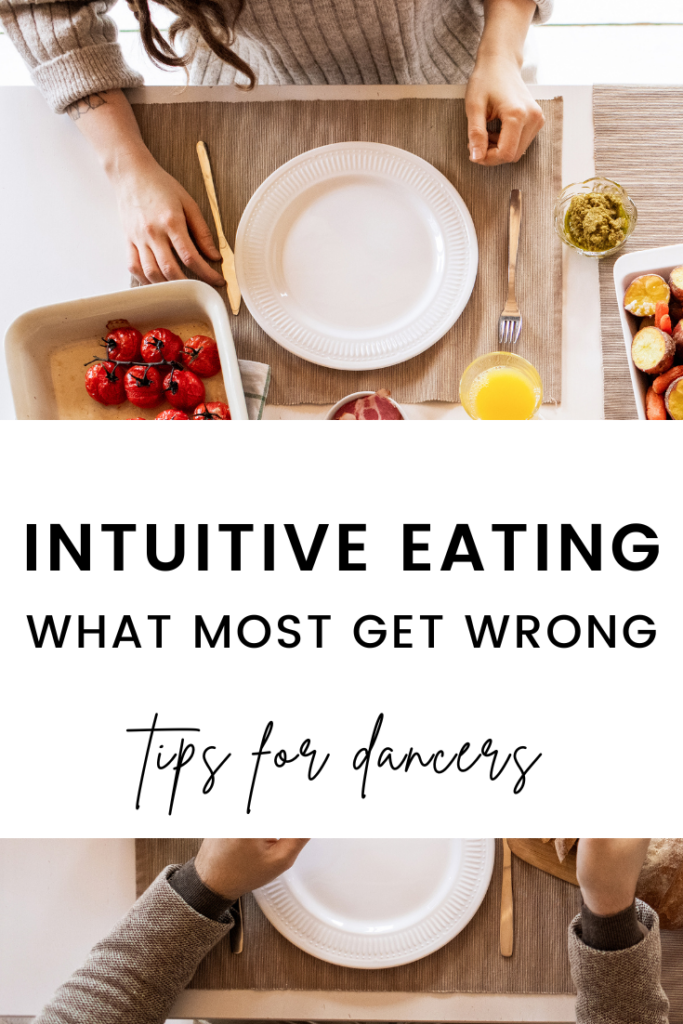There’s a major misconception about Intuitive eating and it is one of the reasons why dancers hesitate to shift to the non-diet approach. At a glance, intuitive eating seems like a plan that involves eating what you want, when you want — without a thought or care.
This depiction is not only oversimplified, but it also misses the primary purpose of intuitive eating. Unlike mainstream diet and “lifestyle changes,” the goal is not to manipulate your body’s weight, shape, or size. At its core, intuitive eating is designed to support your body’s need for nourishment— ensuring that you’re eating an adequate amount of energy (food/calories) to move through life’s vast physical, mental, and emotional complexities. Through the process, you learn how to reconnect to your innate ability to support energy balance. Sure, honoring hunger cues and listening to fullness cues is part of the puzzle. But to get there, the process takes a major conscious effort.
2 reasons why Intuitive eating requires a major effort
#1: Intuition can be unreliable
For dancers especially, hunger cues aren’t consistently reliable. Eating only in response to those physical cues can ultimately lead to under-fueling. I see this often with the dancers who first enroll in The Healthy Dancer®. Busy schedules and above-average activity levels cause hunger cues to go unnoticed until times when eating feels compulsive. This is exacerbated for dancers who currently struggle or have struggled with a history of disordered eating. Chronic under-fueling can impede the body’s ability to communicate its need for energy replenishment. As a result, “eating when hungry and stopping when full” is not the primary focus in recovery from disordered eating.
#2: Diet culture is always loud
Diet and wellness culture, and the messages set forth by it, are everywhere. It takes a lot of conscious effort to unlearn harmful food and body beliefs. It also takes time and patience to relearn more supportive beliefs and implement more sustainable behaviors like not body-checking and not restricting food intake.
Building supportive relationships with both your food choices and your body is an ongoing journey. The good news is that both won’t feel impossible forever. The more you practice challenging those unhelpful food and body beliefs, the better you get at identifying harmful influences, dismantling their oppressive values, and rewriting your brain to craft a supportive self-narrative.
What most get wrong about intuitive eating
Using the intuitive eating paradigm to heal your relationship with food goes beyond simply “following your intuition” to reach a point where food feels “carefree.” In fact, a dancer’s relationship with food is a MAJOR part of their story, and claiming it to be “carefree” feels super invalidating.
Another common misconception about Intuitive Eating that I discuss in this article is that intuitive eating disregards nutrition science (spoiler: this is a major myth… nutrition DOES play a role when we’re learning how to eat intuitively).
Intuitive eating involves so much more than just “ditching” diet culture (hence why the first stage of The Healthy Dancer® framework is to DISMANTLE (not ditch) dancer diet culture. It requires a constant effort— a major willingness to face and challenge the status quo. It involves creating space for the validation of your past experiences and the very triggers that cause you self-doubt. It involves making room for the inevitable discomfort that we experience when breaking the very rules and behaviors that can arguably feel more comfortable and in line with expectations set forth for dancers— ie. avoiding dessert, counting calories, body checking, and spending all day every day in the studio.
The Healthy Dancer® is proactive in shifting their relationships with both food and body
In my work with dancers, I teach them how to master a unique integration between intuitive eating and performance nutrition—one that involves a proactive approach. Not an obsession with food nor a preoccupation with the body, but rather, an intent that helps to liberate dancers from limiting thoughts (like negative body image) and harmful behaviors (like restrictive eating and over-exercising).
The bottom line: this work is anything but “carefree.” It’s really darn hard! But the good news is that support makes it WAY easier. As a dietitian for dancers and certified counselor of intuitive eating, it’s my mission to support your journey. Start with The Healthy Dancer®. It’s free to start and will open a new door for you to achieve your dance goals.



